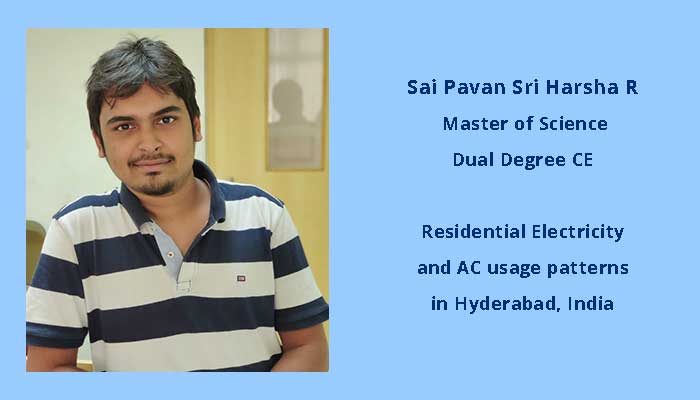November 2022
Sai Pavan Sri Harsha R received his Master of Science – Dual Degree in Civil Engineering (CE). His research work was supervised by Prof. Vishal Garg. Here’s a summary of his research work on Residential Electricity and AC usage patterns in Hyderabad, India:
In India, energy consumption has increased by 50% during the last decade, and with rapid electrification, ever-growing population and increasing incomes, it is expected to grow by 2.3 times in the next two decades. Residential sector alone contributes about 24% of India’s total energy use and is set to go upwards in the coming years. Factors such as appliance ownership, occupant behaviour, thermal comfort levels and the climate conditions are the major contributors to household electricity consumption in India. In the Indian dwellings about 45% of total energy consumed is used to meet the requirement of thermal comfort. Air-Conditioners (AC) usage patterns influence the annual load curve significantly even though it is used only for a few months, for few hours every year. Due to the availability of the limited energy resources, meeting these increasing energy demands is a major challenge. In order to reduce these demands, a deeper understanding of energy consumption patterns and demand profiles along with the factors that are affecting the usage levels will help. A well-organised data driven approach can prove to be one of the solutions to address this challenge.
Based on the recent studies, a thorough understanding of residential energy consumption is required for designing and execution of energy saving measures. Many studies in India focused on survey-based approach in identifying electricity usage patterns of residential sector. However, very few studies were done using the captured real-time data of electricity and indoor temperature patterns. Therefore, there is a need to accurately collect and understand data on energy consumption at household level, which is of interest to end-customers, utilities, appliance manufacturers and most importantly policy makers.
In this thesis, a total of 25 homes from Hyderabad, covering various built types (standalone houses/apartments), income levels (low/medium/high income), occupancy levels and ownership of AC units were monitored during three different seasons (summer, monsoon and winter) by installing electricity and indoor temperature loggers. A detailed survey questionnaire was also conducted to understand dwelling and occupancy characteristics.
Using the monthly energy bills and the survey questionnaire data, a correlation matrix was developed to identify the factors that are affecting the household electricity consumption. It was found that, factors such as ‘connected load’ of home appliances, ‘number of ACs’, ‘number of rooms’ and ‘income levels’ had significant impact on the ‘Annual Energy Consumption (AEC)’ of a dwelling. Seasonal consumption trends were identified using the data from the loggers installed in the dwellings and it was observed that AC home consume nearly three times more than a non-AC home during summer, but the gap between them was minimal during monsoon and in winter. Further investigation was done on AC homes to determine the usage patterns of the primary-AC and the true contribution of it towards the total home energy. On an average, primary-AC was used for 6.2 hours a day with mean daily consumption of 6 kWh/day during summer. It was found that primary-AC was contributing about 44% towards the total home energy.

